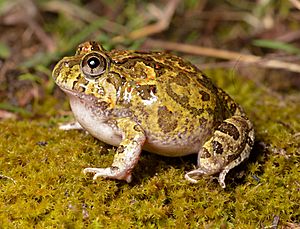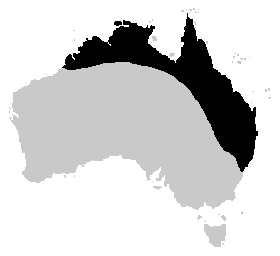Ornate burrowing frog facts for kids
Quick facts for kids Ornate burrowing frog |
|
|---|---|
 |
|
| Conservation status | |
| Scientific classification | |
 |
|
| Range of the ornate burrowing frog (Platyplectrum ornatus). | |
| Synonyms | |
|
The ornate burrowing frog (Platyplectrum ornatum) is a type of ground frog that lives in Australia. It's known for its ability to burrow into the ground. This frog was once called Limnodynastes ornatus but is now part of the Platyplectrum group.
Contents
Discovering the Ornate Burrowing Frog
What Does This Frog Look Like?
This frog is quite small and a bit chubby. It usually grows to about 50 mm (2 inches) long. Its skin can be grey, brown, or yellow. The patterns on its back vary a lot from one frog to another.
You can often spot a butterfly-shaped mark right behind its eyes. Its back is usually covered with small bumps that have red tips. It also has skin folds near its head. The frog's legs and arms have darker stripes or spots. Its toes have a little bit of webbing, but its fingers do not.
Where Do Ornate Burrowing Frogs Live?
Habitat and Behaviour
These frogs live in many parts of Australia. You can find them from western Sydney all the way up to Cape York in Queensland. They also live along both sides of the Great Dividing Range and even in Western Australia.
They live in different places, from wet sclerophyll forests near the coast to drier woodland areas. As their name suggests, these frogs are great at burrowing. They dig into the soil feet first. Special bumps on their feet help them scrape out the dirt.
You usually only see these frogs after a lot of rain, especially during spring or summer. The males like to call out while floating in still water. This includes places like dams, puddles, and flooded grassy areas. Their call is a short, nasal "unk" sound, repeated slowly.
Life Cycle and Reproduction
How Do Ornate Burrowing Frogs Reproduce?
Breeding for these frogs only happens after heavy rainfall. A female frog can lay up to 1600 eggs! She puts them in a small, dome-shaped foam mass. This foam quickly flattens into a single layer of eggs and jelly floating on the water.
The tadpoles can grow up to 50 mm long, but they are usually around 36 mm. Their backs are a dark grey or brown. The sides of their bodies have shiny silver or gold specks, and their tails have grey-silver flecks.
Similar Frog Species
Telling Ornate Burrowing Frogs Apart
The ornate burrowing frog looks very much like Spencer's burrowing frog (Opisthodon spenceri) and some Neobatrachus species. However, you can tell the ornate burrowing frog apart by its less webbed feet and its unique mating call.
See also
 In Spanish: Platyplectrum ornatum para niños
In Spanish: Platyplectrum ornatum para niños



